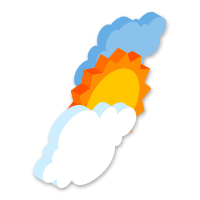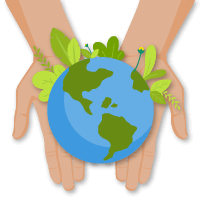- GreenMatch
- Green Intelligence AI
The Power of AI in Reaching Environmental Sustainability


The global population numbers keep climbing, and so does the need for resources. This, combined with the impacts of climate change, places significant pressure on environmental sustainability.
Challenges such as pollution, deforestation, global warming, and increased disease rates have become more urgent than at any other time in history.
Human intelligence and its artificial counterpart form a powerful tool for addressing environmental challenges and their consequences. Artificial Intelligence (AI) can gather, analyse, and interpret vast datasets and facilitate informed decision-making.
This data can be further used to develop cutting-edge solutions to environmental challenges. The medical industry already sees AI in action.
For instance, AI models detect diabetic retinopathy (a disease which causes blindness) with a 97.7% accuracy compared to a trained eye specialist. Apps like Microsoft Seeing AI provide people with visual impairments with real-time audio descriptions of their surroundings.
In this article, we'll explore some key ways AI can empower us to reach environmental sustainability.

Climate modelling and prediction

Climate modelling is the process of using mathematical models to simulate and forecast the Earth's climate system. The objective is to enhance our understanding of the Earth's climate dynamics and its evolution over time, while also forecasting forthcoming climate patterns and trends.
AI has the potential to enhance climate modelling and predictions. This is done by scrutinising extensive datasets gathered from diverse sources, encompassing satellite imagery, weather patterns, and existing climate models.
Moreover, AI contributes to mitigating uncertainties in climate simulations and forecasts, improving their precision and dependability. It does this using machine learning algorithms, neural networks, and deep learning analysis of intricate climate datasets. These techniques are inspired by the function of the human brain and can more quickly discern patterns and correlations, generating predictions based on identified trends.
David Jensen, the coordinator of the United Nations Environment Program's (UNEP's) Digital Transformation sub-programme, gives AI a pivotal role in handling environmental challenges from monitoring deforestation to optimising renewable energy deployment.
"This can be on a large scale – such as satellite monitoring of global emissions, or a more granular scale – such as a smart house automatically turning off lights or heat after a certain time."
Integrating AI into climate modelling and predictions improves their accuracy and reliability and ensures swifter and more efficient analysis of climate data. This valuable information can inform policy decisions and guide climate change adaptation and mitigation initiatives.
Several noteworthy examples of AI-enabled climate modelling and projection systems include Google Earth Engine, Climate.ai, IBM Watson, and Microsoft Azure. These platforms leverage AI capabilities to harness the vast potential of data analysis. They offer powerful tools for advancing our comprehension of climate dynamics and facilitate more informed decision-making in the face of environmental challenges.
Resource management

Agricultural resource management involves optimising water and energy use through AI algorithms. They analyse data from sensors and weather patterns to provide real-time insights into soil moisture and crop water needs.
AI optimises energy usage in farming, enhancing sustainability and minimising ecological footprints. In broader energy management, smart grids, often AI-powered, efficiently integrate renewable energy into existing infrastructure.
AI algorithms can analyse vast amounts of historical data and market trends to forecast energy demand, optimise distribution, and manage fluctuations in renewable sources.
AI, in conjunction with renewable energy, has the potential to:
- Accelerate the Net-Zero transition by informing the maintenance teams of potential equipment failures and optimising maintenance schedules. This leads to improved collaboration across the energy ecosystem and enhanced energy efficiency.
- Increase the availability and efficiency of solar, wind, hydroelectric, and biomass energy resources through machine learning, the Internet of Things, and data analysis. This optimises the supply chains, forecasts demand, balances the power grid and monitors assets.
- Optimise businesses by revealing patterns of energy usage and areas of inefficiency and improving the decision-making regarding EV charging infrastructure.
For example, AI can help power companies adjust energy generation and distribution by analysing energy demand based on weather patterns, industrial activity, and seasonal consumer behaviour.
Sustainable farming

AI algorithms analyse diverse datasets from sources like drones and satellites. This empowers farmers with informed decisions on resource allocation, crop selection, and pest control. Farmers can optimise the nutrient application and prevent excessive fertiliser and potential pollution.
Drones with sensors aid in remote sensing, field mapping, and monitoring crop health. Soil and weather sensors provide real-time data for precision agriculture.
- Remote sensing is collecting information about crops, soil, and environmental conditions. It's essential for monitoring crop health and soil properties or detecting water stress and, as a result, making informed decisions and improving productivity.
AI helps to process and understand remote sensing data, eliminate mistakes in further mapping and avoid time and resource waste.
- Field mapping is a process of creating up-to-date maps of specific areas by collecting geographic and environmental data.
AI assists in object and change detection and image classification and lead to a better resource management.
- Monitoring crop health is required for early detection of issues, reduced costs, resource optimisation and data-driven decision-making.
AI-powered drones and sensors provide in-depth data which allows farmers to identify weeds or pests and nutrient deficiencies. This way, farmers can apply pesticides and chemical treatments more selectively and minimise the environmental impact.
Also, sustainable practices involve AI-driven recommendations for crop rotations and diversification based on historical data, enhancing soil fertility.
Precision irrigation and early pest detection through AI-powered drones contribute to water conservation and reduced pesticide use. Such drones analyse crop health and identify signs of stress, disease or pest infestation allowing farmers to take timely action.
Resource optimisation, including energy-efficient machinery and supply chain improvements, further supports environmentally friendly and efficient agricultural systems.
Natural disaster prediction and response

AI has significantly advanced natural disaster prediction and response. Machine learning algorithms analyse vast datasets through sensors, satellite imagery, and historical data. This data can be used to identify patterns, trends, and potential hazards that may indicate an impending disaster.
For instance, In hurricane forecasting, AI models analyse atmospheric conditions and historical storm data for more accurate predictions, aiding evacuation planning and resource allocation.
Also, AI analyses seismic activity data, satellite imagery, and historical patterns in earthquake prediction to identify precursors, enabling warnings and mitigation efforts.
For example, after the 2023 earthquake in Turkey and Syria, AI was used to assess the damaged areas and prioritise resources during the building damage assessment.
Microsoft AI for Good Lab collaborated with Planet Labs and other satellite providers to deliver building level damage estimates and assist Turkey's rescue authorities in their response efforts. Within the first 3 days after the disaster, the AI methods and high-resolution satellite images were used to analyse the situation.
The assessment results concluded that 3,849 buildings were damaged or destroyed in the four cities of Marash, Trukoglu, Nurdagi, and İslâhiye, with over 160,000+ people having been affected within those areas.

These examples showcase the valuable role of AI in providing critical information for authorities and communities to enhance disaster preparedness and response strategies.
Supply chain optimisation and transparency

Imagine a world where supply chains are efficient, environmentally friendly, and ethically responsible. That's the promise of AI and blockchain, two powerful technologies revolutionising how we manage the flow of goods from production to consumption.
Blockchain is a decentralised digital ledger technology that stores data on a file connected to specific blocks on the chain. Unless you sell that data, it can't be shared with anyone.
Blockchain organises data into secure and tamper-proof blocks using cryptographic hashes, ensuring integrity and order. It employs consensus mechanisms to prevent interference, enabling transparent tracking in supply chains to address issues like counterfeiting and compliance violations.
With AI, businesses can predict the right amount of inventory, avoiding the wastefulness of overproduction and the environmental impact that comes with it. AI can accurately predict future demand or shortages, recognise patterns and fraudulent activity, or improve supply chain management.
When AI predicts with blockchain's transparency, supply chains optimise for efficiency, environmental sustainability, and ethical responsibility. This is a win-win for businesses, consumers, and the planet.
Challenges
Despite all the eco-friendly solutions the AI brain can bring, there are ongoing debates regarding its own environmental sustainability. The computed data, stored and processed in the cloud, creates invisible harmful environmental impacts, let alone the environmental costs of training the AI models.
For example, BERT – a machine learning framework for natural language processing (NLP). It's considered the most expensive model in terms of computational complexity and the amount of data required to train it.
BERT is designed to improve contextual understanding of unlabelled text across various tasks. It's widely used for text prediction, text generation, and summarisation, as well as in chatbots and question answering.
Despite such a massive technological input, its carbon footprint is just as huge. It is 1,400 pounds of carbon dioxide equivalent compared to a round-trip trans-American flight for one person.
This way, ironically, while resolving the above-mentioned environmental challenges, AI imposes itself-driven climate-damaging issues.
The question arises: What can be done to keep AI-driven use in balance?
There are a couple of suggestions.
- Improve carbon accounting: deliver faster and more precise data on carbon footprint and sustainability using tools to visualise and comprehend environmental impact.
- Calculate the carbon footprint: get estimates about emissions based on cloud provider, location, and hardware.
- Relocate the machine-learning operations to environmentally friendly places: for example, some data centres can powered by hydroelectricity.
- Enhance transparency measures: include energy emissions measurements alongside research performance and accuracy metrics.
Prospects and potential advancements
As we've seen, AI and sustainability go hand in hand when addressing some of the most pressing environmental challenges we face today. AI is already changing from climate modelling and prediction to sustainable farming and disaster response.
However, it's important to remember that AI is not a silver bullet. Some challenges need to be addressed, such as the environmental impact of training and running AI models. We need to be mindful of these challenges and work to develop solutions that will allow us to use AI responsibly and sustainably.
Looking ahead, the future of AI and its potential to help us create a more sustainable world is quite optimistic. With careful planning and implementation, sustainable AI can be a powerful force for good in the fight against environmental challenges.
We must continue to develop AI technologies and use them responsibly to create a more sustainable future for all.
We strive to connect our customers with the right product and supplier. Would you like to be part of GreenMatch?

